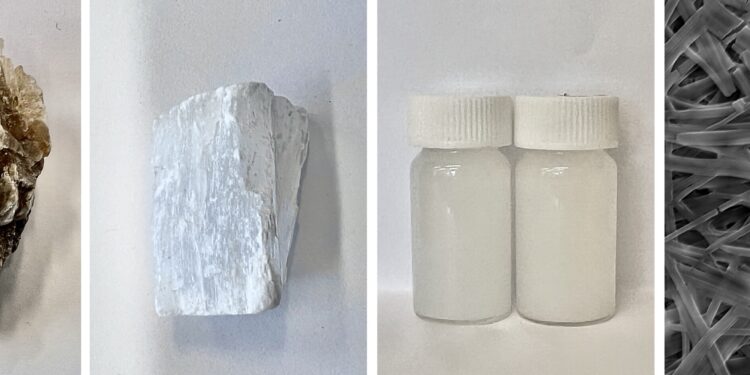Two raw rocks used by researchers (left). The vials show the nanobelts in water, with a close-up of the actual nanobelts (right). Credit: University of Sussex
Researchers from the University of Sussex have discovered the transformative potential of Martian nanomaterials, potentially opening the door to sustainable habitation on the Red Planet.
Using resources and techniques currently applied on the International Space Station and by NASA, Dr Conor Boland, Senior Lecturer in Materials Physics at the University of Sussex, led a research group which investigated the potential of nanomaterials , incredibly tiny components thousands of times smaller than nanomaterials. a human hair – for clean energy production and building materials on Mars.
By taking what was considered waste by NASA and applying only sustainable production methods, including water-based chemistry and low-energy processes, researchers were able to identify the electrical properties of gypsum nanomaterials, opening the door to potential production of clean energy and sustainable technologies on Mars.
The research is published in the journal Advanced functional materials
Dr Conor Boland said: “This study shows that the potential of nanomaterials is literally out of this world. Our study builds on recent research done by NASA and takes what was considered waste, essentially pieces of rock, and turns it into transformative materials. nanomaterials for a range of applications, from creating a clean hydrogen fuel to developing a transistor-like electronic device to creating an additive for textiles to increase their robustness.
“This paves the way for sustainable technology and construction on Mars, but also highlights the broader potential for ecological breakthroughs here on Earth.”
To achieve this breakthrough, researchers used NASA’s innovative method to extract water from Martian gypsum, which is dehydrated by the agency to obtain water for human consumption. This produces a byproduct called anhydrite, which is considered waste by NASA but is now proving extremely valuable.
Sussex researchers have transformed anhydrite into nanobelts – essentially tagliatelle-shaped materials – demonstrating their potential to provide clean energy and sustainable electronics. Additionally, at each stage of their process, water could be continually collected and recycled.
Dr Boland added: “We are optimistic that this process is feasible on Mars, as it only requires natural materials. Everything we used could, in theory, be replicated on the Red Planet. This is arguably the most important objective of the project. make the Martian colony sustainable from the start.”
Although large-scale electronics production may prove impractical on Mars due to the lack of clean rooms and sterile conditions, anhydrite nanobelts show promise for clean energy production on Earth and could, later, still have a profound effect on sustainable energy. production on Mars.
More information:
Cencen Wei et al, Quasi-1D anhydrite nanobelts from sustainable liquid exfoliation of terrestrial gypsum for the future of Martian electronics, Advanced functional materials (2023). DOI: 10.1002/adfm.202310600
Provided by University of Sussex
Quote: Using ‘waste’ from recent NASA research, scientists create transformative nanomaterials (December 20, 2023) retrieved December 21, 2023 from
This document is subject to copyright. Apart from fair use for private study or research purposes, no part may be reproduced without written permission. The content is provided for information only.



